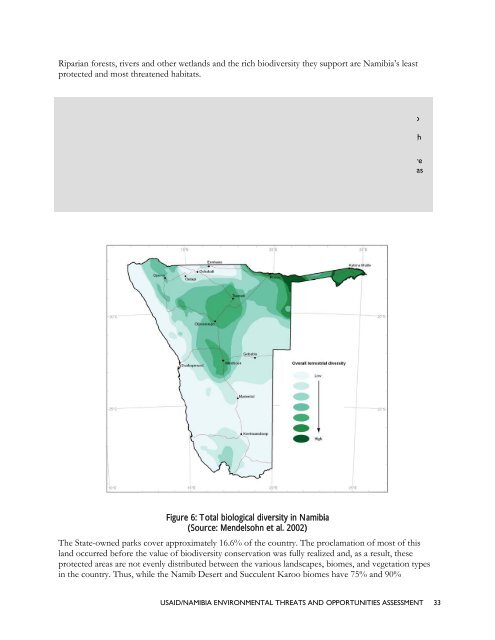usaid/nambia environmental threats and opportunities assessment
usaid/nambia environmental threats and opportunities assessment
usaid/nambia environmental threats and opportunities assessment
Create successful ePaper yourself
Turn your PDF publications into a flip-book with our unique Google optimized e-Paper software.
Riparian forests, rivers<br />
<strong>and</strong> other wetl<strong>and</strong>s <strong>and</strong> the rich biodiversity they support are Namibia’s least<br />
protected <strong>and</strong> most threatened habitats.<br />
Biodiversity rich <strong>and</strong> endemic hotspots<br />
Biodiversity is highest in northeastern Namibia (Figure 6), which not only receives the highest rainfall but also<br />
supports perennial rivers, wetl<strong>and</strong>s, <strong>and</strong> varied woodl<strong>and</strong> habitats. Many species in the north are also more<br />
tropical, with ranges that extend into neighboring countries (Botswana, Zambia, Angola, <strong>and</strong> Zimbabwe). High<br />
diversity is<br />
also centered<br />
on the karstveld (Tsumeb-Otavi area).<br />
Although biodiversity richness is concentrated in the<br />
northeast, the majority of Namibia’s endemic species are<br />
found in the dry western<br />
<strong>and</strong> northwestern regions (Barnard 1998, Mendelsohn et al. 2002). The highest areas<br />
of endemism occur east of the coastal national parks<br />
<strong>and</strong> west of Etosha National Park, <strong>and</strong> south of eastern<br />
Etosha via<br />
Windhoek to<br />
the Naukluft Mountains <strong>and</strong><br />
into the Sperrgebiet. Patterns of endemism reflect the<br />
importance of arid habitats in supporting unique <strong>and</strong> specially adapted species.<br />
Figure<br />
6: Total biological diversity in Namibia<br />
(Source: Mendelsohn et t al. 2002)<br />
The State-owned parks<br />
cover approximately 16.6% of the country. The proclamation of most of this<br />
l<strong>and</strong> occurred before the value of biodiversity conservation was fully realized <strong>and</strong>, as a result, these<br />
protected areas are not<br />
evenly distributed between the various l<strong>and</strong>scapes, biomes, <strong>and</strong> vegetation types<br />
in the country. Thus, while the Namib Desert <strong>and</strong> Succulent Karoo biomes have 75% <strong>and</strong> 90%<br />
USAID/NAMIBIA ENVIRONMENTAL THREATS AND OPPORTUNITIES ASSESSMENT 33

















